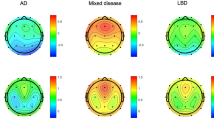Abstract.
The accuracy of the clinical diagnosis of dementia with Lewy bodies (DLB) remains poor, especially in early phases of the disease, in spite of applying current consensus diagnostic criteria. The need for supportive diagnostic tools is therefore warranted. In this study EEG recordings showed a main pattern of bilateral frontal intermittent rhythmic delta activity (FIRDA) in 7 of 10 patients, aged 58–83 years, 8 of whom were diagnosed as affected by “probable” and 2 by “possible” DLB. Conversely, the same EEG abnormality was found only in 2 of 9 age-matched patients, 8 of whom had “probable” and 1 “possible” Alzheimer's disease, according to NINCDS-ADRDA criteria, taken as controls. The degree of cognitive impairment was comparable among the two groups of patients. If these findings will be confirmed in a larger series, FIRDA, even though an aspecific EEG pattern, could be of value in improving the diagnostic accuracy of DLB.
Similar content being viewed by others
Author information
Authors and Affiliations
Additional information
Correspondence to S. Calzetti
Rights and permissions
About this article
Cite this article
Calzetti, S., Bortone, E., Negrotti, A. et al. Frontal intermittent rhythmic delta activity (FIRDA) in patients with dementia with Lewy bodies: a diagnostic tool?. Neurol Sci 23 (Suppl 2), s65–s66 (2002). https://doi.org/10.1007/s100720200072
Issue Date:
DOI: https://doi.org/10.1007/s100720200072




